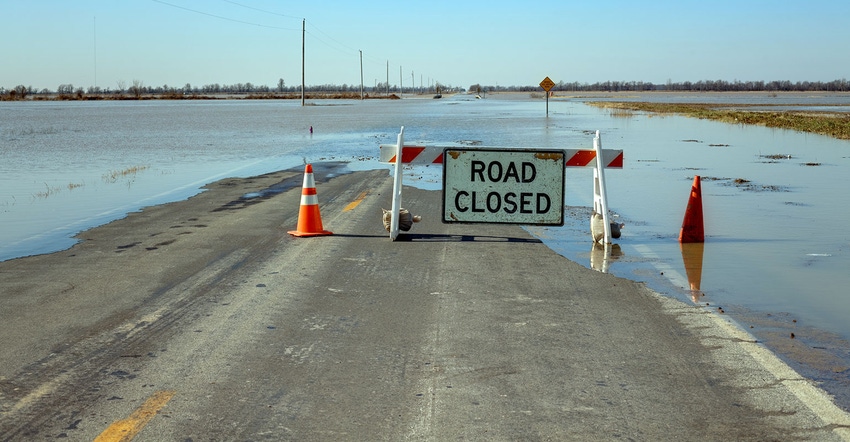September 9, 2019

Flood waters are simultaneously a blessing and a curse for producers, says Dr. David Fernandez, Extension livestock specialist and interim assistant dean of academic programs for the University of Arkansas at Pine Bluff (UAPB) School of Agriculture, Fisheries and Human Sciences. After flooding occurs on their property, producers often wonder about the repercussions — or potential benefits — to the soil.
“Flooding can change entire plant communities for the short term or for decades,” he said. “Flood waters can bring much needed nutrients and new, fertile topsoil or they can wash them away. They can carry pollutants and pathogens away or deposit them on the surface of the land.”
Fernandez said the effects of flooding vary depending on many factors, including water speed, the location of where the flooding occurred, and soil type and plant communities on the flooded land. It is also important to consider the matter that might have been washed into the flood waters upstream — agricultural and industrial chemicals, sewage, oils and other petroleum products, or potentially infectious microorganisms.
“It is impossible to guess what may have been left behind on land after a flood,” he said. “In all cases, the land will be different, and producers should conduct new soil tests to best manage the changed conditions.”
Fernandez said producers can benefit from learning about some of the basic effects of flooding on their land, crops and livestock.
Flooding and pollution on the land
Flood waters contain pollutants that were washed off city streets and parking lots. If sewage treatment facilities are flooded, sewage byproducts — along with pathogenic bacteria such as E. coli and salmonella — will be washed into the river.
“Much of the pollution carried in flood waters is diluted by the vast volume of water to levels that should have little to no effect on the land,” Fernandez said. “This is not to say flood waters cannot leave significant, concentrated deposits of pollutants behind in sediments where the water pooled or receded slowly.”
If landowners have concerns about a specific pollutant, soil samples should be sent to a lab for testing. They should keep in mind that the risk associated with any pollutant involves three components — dose, route of administration and time of exposure.
“Consider this simplified example involving water,” he said. “You can swim in a pool all day and suffer no ill effects, but if you inhale only a small amount of that pool water, you will drown. On the other hand, you can have a humidifier in your room and breathe the same amount of water over the course of the day and be fine.”
Flooding’s effect on crop growth
Topsoil in the land close to a river — where the current was more rapid — may be completely washed away after a flood, Fernandez said. Erosion will be significant in areas near the fast-moving water.
“Land farther away from the river, where the water moved more slowly, receded slowly or where it formed temporary pools, may have received significant deposits of sediments,” he said. “These areas will likely have significant changes in soil composition.”
Flooded soils tend to lose soluble nutrients such as nitrate, significantly inhibiting plant growth. The waterlogged soils also collapse quickly through the dispersion of clay particles, which results in compaction, especially in soils with high salt content. With the resulting poor soil structure, salt can easily build up in surface soil and cause soil salinity issues.
Soil has air spaces that allow plant roots to breathe. When land is flooded, those spaces are filled with water and fine sediments, causing plants to drown. This leads to anaerobic (oxygen-reduced) conditions in the soil, which causes microbes and invertebrates such earthworms, dung beetles, ground-nesting bees and pest insects to die.
“On the other hand, microbes that prefer anaerobic conditions thrive,” Fernandez said. “Many anaerobic organisms are pathogens, so there is an increased risk of waterborne and soilborne disease in the short term.”
There will still be a seedbed of plants available for regrowth, but flood-tolerant plants, including many weeds, may quickly become dominant as flood-sensitive plants try to recover.
“Producers will likely need to focus on weed control more than they normally would until their crop plants recover,” Fernandez said. “Over time the soil will return to aerobic conditions in which oxygen is present. The soil’s organisms will then also return.”
Flooding does not always spell doom and gloom for the soil, he said. Nutrients can also move from the subsoil to the surface, becoming more available to crop plants and improving growth.
“There is a reason river deltas make for especially good farmlands,” Fernandez said. “Nutrients from soils upriver are deposited along the banks as rivers rise and fall with flood waters.”
Flooding’s effect on livestock
The impact of flooding on livestock includes potential increases in gastrointestinal disease and parasitic infections, Fernandez said. Diseases that are spread in drinking water, such as leptospirosis, campylobacteriosis, E. coli and salmonella infections, may cause diarrhea in calves, kids or lambs.
“Two types of parasites of particular concern are protozoa and helminths (worms),” he said. “Cryptosporidia and coccidia are common waterborne parasites that damage the gastrointestinal tract of livestock and cause diarrhea, especially in young animals.
Liver flukes and nematodes thrive under damp conditions. Liver flukes can reduce livestock productivity without ever giving clear signs of what is causing the problem, while nematodes such as the barber pole worm can kill sheep and goats, significantly impacting production.
“Considering the potential risk of disease and infections in livestock, increased vigilance is warranted for the months following a flood,” Fernandez said.
About the Author(s)
You May Also Like




